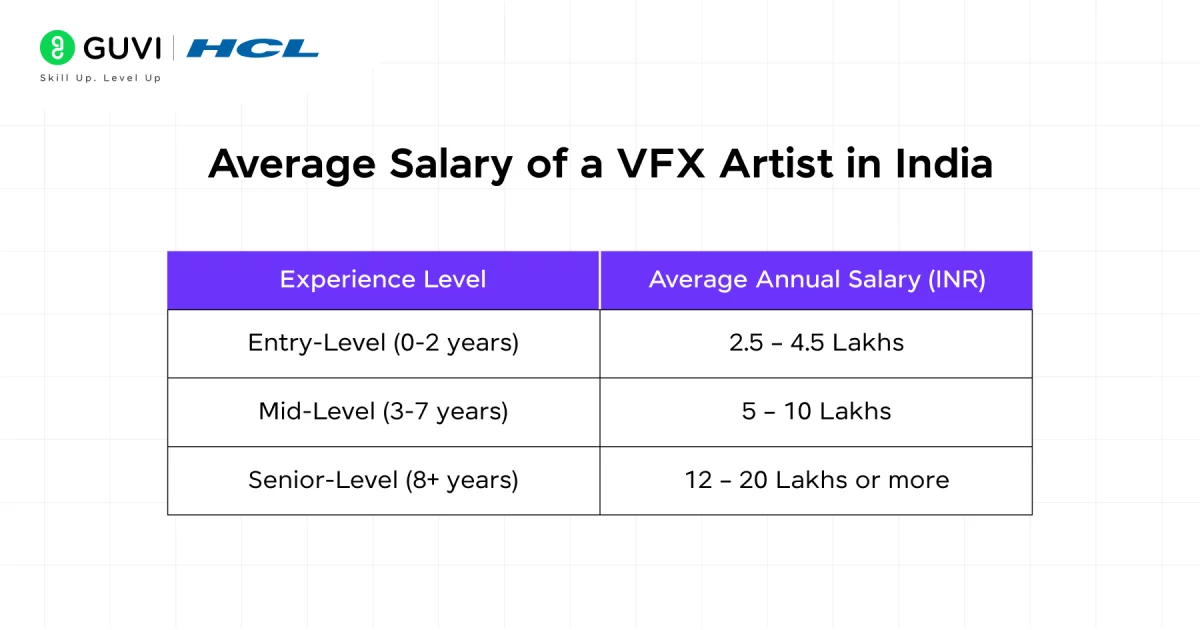
VFX Artist Salary in India: A Comprehensive Guide
Jan 23, 2025 4 Min Read 6174 Views
(Last Updated)
If you’ve ever been mesmerized by the mind-blowing visuals in blockbuster Hollywood movies, dazzling advertisements, or immersive video games, you’ve witnessed the magic of visual effects (VFX).
Behind these stunning visuals are VFX artists who bring imagination to life using cutting-edge technology and creative skills. But what is the average VFX artist salary in India?
Creativity is important but at the same time, it should be a rewarding career as well. Let’s dive into everything you need to know about VFX artist salaries in India and what influences them. Without further ado, let us get started!
Table of contents
- Who is a VFX Artist?
- Average Salary of a VFX Artist in India
- Entry-Level Salary (0–2 years of experience):
- Mid-Level Salary (3–7 years of experience):
- Senior-Level Salary (8+ years of experience):
- Salary of Different Roles of VFX Artists in India
- Salary Ranges and Role Descriptions for VFX Artists in Top Companies in India
- What Affects a VFX Artist’s Salary? Factors to Consider
- Experience
- Skill Set
- Location
- Industry
- Company Reputation
- What Skills Help You Earn More as a VFX Artist?
- Proficiency in Industry-Standard Software
- Understanding of Emerging Technologies
- Coding and Scripting Abilities
- Conclusion
- FAQs
- What does a VFX artist do?
- How much can a VFX artist earn in India?
- What skills are needed to become a successful VFX artist?
- What are the best cities in India for VFX jobs?
- Can a VFX artist work internationally?
Who is a VFX Artist?

A VFX (Visual Effects) artist is a professional who uses software and creativity to create visual elements that cannot be captured by a camera. Whether it’s creating realistic explosions, fantastical creatures, or immersive environments, VFX artists are the masterminds behind these effects.
They collaborate with filmmakers, game developers, and ad agencies to deliver visual content that elevates storytelling.
Average Salary of a VFX Artist in India

The VFX artist salary in India can vary widely depending on experience, location, company, and skill set.
Entry-Level Salary (0–2 years of experience):
If you’re just starting as a VFX artist, your annual salary typically falls between ₹2.5 lakh to ₹4.5 lakh. At this stage, you’ll be working on smaller tasks like basic compositing, rotoscoping, or cleanup work.
While the pay might seem modest, this phase is crucial for building a strong portfolio and gaining hands-on experience.
Mid-Level Salary (3–7 years of experience):
With 3–7 years of experience, you can expect your salary to rise significantly, ranging from ₹5 lakh to ₹10 lakh per year. By this point, you’ll have honed your technical skills and might take on more advanced tasks, like 3D modeling, creating visual effects sequences, or leading small teams.
Your ability to deliver high-quality work within tight deadlines will make you a valuable asset.
Senior-Level Salary (8+ years of experience):
Experienced VFX artists with over 8 years in the field earn anywhere between ₹12 lakh to ₹20 lakh or more annually.
At this stage, you’ll likely be in a leadership role, such as a VFX Supervisor or Technical Director, overseeing entire projects or teams. Your expertise in advanced tools and techniques, combined with creative problem-solving, will set you apart in the industry.
To summarize:
| Experience Level | Average Annual Salary (INR) |
| Entry-Level (0-2 years) | 2.5 – 4.5 Lakhs |
| Mid-Level (3-7 years) | 5 – 10 Lakhs |
| Senior-Level (8+ years) | 12 – 20 Lakhs or more |
These figures are approximate and can vary based on factors like your skills, location, and the type of projects you work on.
Salary of Different Roles of VFX Artists in India
Salary Comparison of Animation and VFX Roles in IndiaSalary Ranges and Role Descriptions for Different Types of VFX Roles
| Role | Annual Salary Range (LPA) | Role Description | Skills Required |
| Animator | ₹1.8 LPA – ₹7.2 LPA | Creates character movements, expressions, and actions for animated sequences. | Proficiency in Autodesk Maya, Blender, 3ds Max; Strong understanding of animation principles. |
| VFX Artist | ₹1.2 LPA – ₹9 LPA | Designs and implements visual effects for films, games, and advertisements. | Knowledge of tools like Nuke, After Effects, Houdini, Maya; Creativity and problem-solving skills. |
| Compositor | ₹2.4 LPA – ₹9.6 LPA | Combines various visual elements (2D and 3D) into a cohesive final product. | Expertise in compositing tools like Nuke, Adobe After Effects; Strong sense of timing and color grading. |
| Rigger Artist | ₹1.8 LPA – ₹6 LPA | Develops skeletal frameworks for characters to enable lifelike movement. | Understanding of rigging tools in Maya, 3ds Max; Knowledge of anatomy and kinematics. |
| Storyboard Artist | ₹2.4 LPA – ₹8.4 LPA | Designs and visualizes the storyline with sketches and illustrations. | Artistic drawing skills, storyboard tools like Toon Boom, Photoshop; Visual storytelling ability. |
| VFX Supervisor | ₹9 LPA – ₹18 LPA | Oversees the entire VFX process, ensuring alignment with creative and technical goals. | Leadership skills, advanced knowledge of VFX tools like Houdini, Nuke; Project management experience. |
Salary Ranges and Role Descriptions for VFX Artists in Top Companies in India
Below is a detailed description of Salary Ranges and Role Descriptions for VFX Artists in India:
| Company | Salary Range (Monthly) | Annual Salary Range (LPA) | Role Description |
| Technicolor | ₹30,000 – ₹1,20,000 | ₹3.6 LPA – ₹14.4 LPA | Provides post-production services, including 3D and CGI work for films and TV series. |
| DNEG (Double Negative) | ₹40,000 – ₹1,60,000 | ₹4.8 LPA – ₹19.2 LPA | Creates award-winning effects for Hollywood and international film projects. |
| Byju’s (In-house VFX Team) | ₹20,000 – ₹80,000 | ₹2.4 LPA – ₹9.6 LPA | Designs educational visual content for interactive and immersive learning platforms. |
What Affects a VFX Artist’s Salary? Factors to Consider

A VFX artist salary can vary significantly based on several factors. Here’s a detailed breakdown of the key elements that influence how much a VFX artist earns in India:
1. Experience
Experience is the most critical factor in determining salary. As you gain experience, you improve your technical skills, speed, and ability to handle complex projects, making you more valuable to employers.
2. Skill Set
VFX is a highly technical field, and your expertise with specific software and techniques directly impacts your earning potential.
3. Location
The city you work in affects your salary due to differences in demand and the cost of living.
High-Paying Cities in India:
- Mumbai: Known as the hub of Bollywood, with top studios offering competitive pay.
- Bangalore and Hyderabad: Home to gaming studios and IT firms integrating VFX into their projects.
- Chennai: Known for its growing VFX industry, especially in regional cinema.
Smaller Cities: Studios in smaller cities may offer lower pay, but they can be a good starting point for beginners.
4. Industry
The industry you work in determines the type of projects you handle, and some industries pay more than others.
Comparison by Industry:
- Film and Television: These sectors typically pay the most, especially for blockbuster movies and high-budget productions.
- Gaming: Though slightly lower than film, gaming salaries are growing rapidly due to the booming gaming industry.
- Advertising: While ads may not pay as much as films, they are often quicker projects, which means you can work on multiple assignments in a short period.
5. Company Reputation
Established studios often have bigger budgets and attract large-scale projects, which means higher salaries for employees.
Examples of Top Studios:
- Global names like DNEG, Technicolor, MPC, and Framestore are known for offering competitive salaries.
- Indian studios like Prime Focus and Red Chillies VFX are also reputed employers.
Understanding these factors can help you make informed career decisions and maximize your earning potential as a VFX artist.
What Skills Help You Earn More as a VFX Artist?

In the VFX industry, your skills are your biggest asset. Employers value artists who have a mix of creative, technical, and specialized abilities. Here’s a detailed look at the skills that can help you earn more as a VFX artist:
1. Proficiency in Industry-Standard Software
To create stunning visual effects, mastering the right tools is crucial. Some of the most in-demand software includes:
- Autodesk Maya and 3ds Max: Used for 3D modeling, animation, and rendering.
- Houdini: Highly sought-after for creating procedural effects like explosions, fire, water, and smoke.
- Nuke: A top choice for compositing and integrating visual elements seamlessly into footage.
- Adobe After Effects: Widely used for motion graphics and post-production.
- Unreal Engine and Unity: Essential for real-time VFX, especially in gaming and AR/VR projects.
Having expertise in one or more of these tools can set you apart and lead to higher pay.
2. Understanding of Emerging Technologies
The VFX field is evolving rapidly, and staying ahead of the curve with new technologies can increase your earning potential. Key areas to focus on include:
- Augmented Reality (AR) and Virtual Reality (VR): These technologies are becoming integral to gaming, advertising, and entertainment.
- Artificial Intelligence (AI): Learning how AI tools can automate and enhance workflows in VFX can give you a competitive edge.
3. Coding and Scripting Abilities
While creativity is essential, technical skills like coding and scripting can elevate your career. Many studios look for VFX artists who can:
- Write Python scripts to automate tasks in software like Maya or Houdini.
- Use programming skills to develop custom tools or plugins.
- Solve complex technical problems efficiently.
These skills not only make you more versatile but also open doors to roles like Technical Director, which come with higher salaries.
By mastering these skills and continuously upgrading your abilities, you can increase your value in the VFX industry and secure higher salaries.
If you want to learn VFX through a step-by-step process guided by an actual VFX mentor, consider enrolling in GUVI’s Adobe Certified VFX Course with AI Integration that not only teaches you everything about VFX, but also provides you with an industry-grade certificate!
Conclusion
In conclusion, becoming a VFX artist in India can be both creatively satisfying and financially rewarding. While entry-level salaries may seem modest, the potential for growth is immense if you’re willing to invest time and effort into honing your skills. Whether you’re passionate about working in Bollywood, gaming, or international projects, the VFX industry offers a dynamic and promising career path.
If you’re just starting out, focus on building your skill set and portfolio. With determination and persistence, you’ll find your niche in this exciting field.
FAQs
A VFX artist creates visual effects that cannot be filmed in real life, like explosions, fantasy creatures, or immersive environments. They use software like Maya, Houdini, and After Effects to enhance movies, games, and advertisements.
Salaries vary by experience: entry-level artists earn ₹2.5–4.5 lakh/year, mid-level artists earn ₹5–10 lakh/year, and senior-level professionals can earn ₹12–20 lakh/year or more.
Key skills include proficiency in software like Maya, Nuke, and Houdini, artistic fundamentals (color, composition), coding (Python), and specialization in high-demand areas like 3D animation, particle effects, or AR/VR.
Cities like Mumbai, Bangalore, Hyderabad, and Chennai are hubs for VFX jobs due to their thriving entertainment and gaming industries. Salaries and opportunities are higher in these metropolitan areas.
Yes, skilled VFX artists are in demand globally, especially in countries like Canada, the US, and the UK. Working on international projects can provide higher pay and exposure to advanced technologies.































Did you enjoy this article?